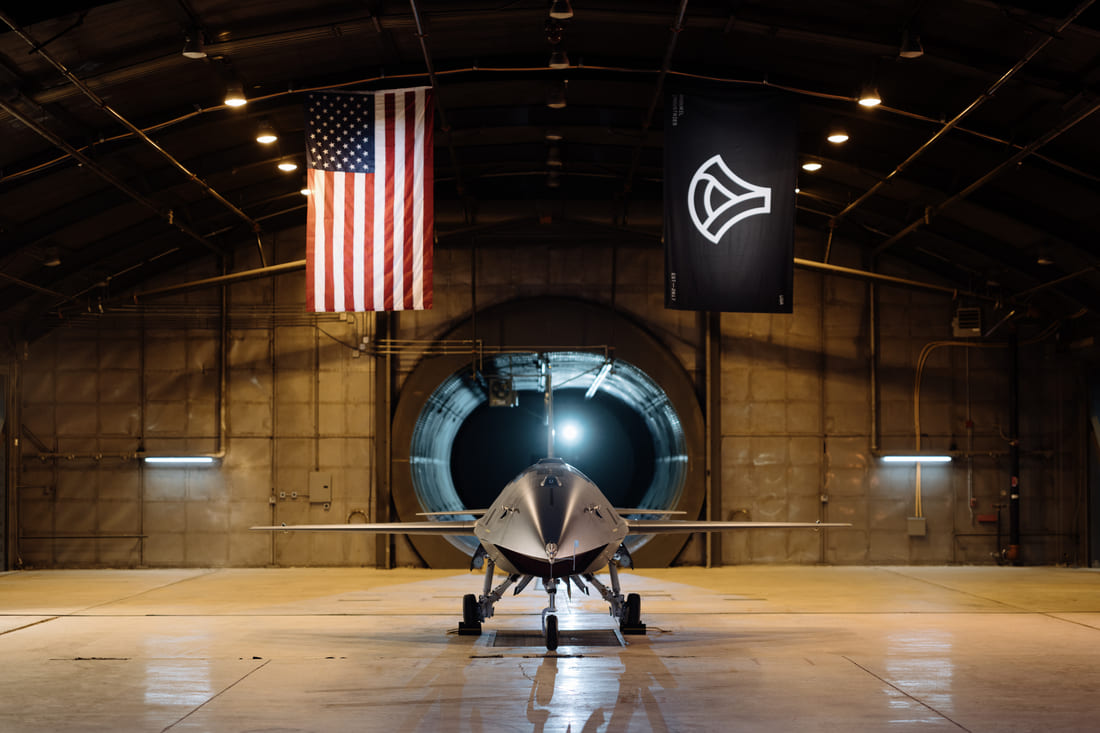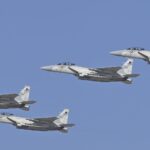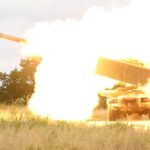Air Force leadership set mid-October for the first flight of Anduril’s YFQ-44A, the company’s entrant in the Collaborative Combat Aircraft program. The aircraft will use push-button departure and recovery with no conventional stick and throttle while human operators watch from the ground.
Multiple YFQ-44A airframes sit in ground test, including vehicles used to exercise taxi logic and to shake out avionics integration. The flight profile for the opening sortie will run off a preplanned card executed by autonomy software native to the jet. Company officials tied the short slip from a summer window to extra software work and to the decision to avoid a traditional remote piloting setup for takeoff and landing.
The first sortie will proceed with human oversight and with a bounded test card focused on the core flight control stack. Anduril’s team framed this as an efficiency choice, since building a bespoke ground control station for manual launch and recovery would add a parallel development line they do not intend to field.
Mid-October target for semiautonomous YFQ 44A first flight
Diem Salmon, who oversees air dominance and strike at the firm, told reporters the aircraft will roll, take off, fly the card, and land at the push of a button with the route and actions laid out in advance. “There is no stick and throttle,” she said, underscoring the goal to clear autonomy at the beginning of flight test rather than after initial manual sorties. The company has already run hands-off taxi sequences to fixed points and back to the line.
Jason Levin, the senior engineering lead for the effort, explained that the team chose to avoid building a dedicated launch and recovery console. He characterized that path as a distraction from the main problem set, which sits in the autonomy and integration layers. The first flights will validate the aircraft’s semiautonomous stack and basic handling. Mission behaviors will follow in later cards once core stability and fault management prove out.
Ground testing began in May, when the company and the Air Force publicly showed the aircraft and started systems work on instrumented prototypes. The hardware line includes multiple vehicles to help run parallel checks, which the firm says will support a broader envelope expansion campaign in 2026.
The Air and Space Forces Association week at National Harbor provided the setting for the most detailed brief so far. Secretary of the Air Force Troy Meink used the venue to set expectations for timing and to emphasize readiness and innovation themes.
General Atomics YFQ 42A flight testing since late August 2025
General Atomics reached flight test first with its YFQ-42A in late August at an undisclosed site in California, according to the company’s statement. The firm conducted the opening flights using a remote pilot, describing that method as the best way to gather detailed performance data and reduce early risk. Program spokespeople pointed to the company’s long history with automatic launch and recovery on platforms such as Reaper and Avenger.
The differing first flight philosophies now sit in clear view. General Atomics prefers a human on the controls during initial climbs, descents and pattern work, then steps down to higher autonomy levels when the test team is satisfied with the airframe’s responses. Anduril aims to clear the autonomy baseline first to avoid retooling ground infrastructure and to move faster through later software drops.
According to industry sources, the service sees benefit in testing two paths at once since early data will inform how much man-in-the-loop is necessary for future production articles. No requirement change has been announced that would force one contractor to mirror the other’s approach during the initial sorties.
Program context CCA Increment 1 fleet goals and near-term milestones
The Collaborative Combat Aircraft construct seeks a large fleet of uncrewed aircraft to team with frontline fighters and to execute strike, reconnaissance, electronic attack, and deception. Earlier decisions narrowed Increment 1 to two vendors, with a competitive production award expected in fiscal 2026. The service began ground testing in May and has since moved into flight tests with one of the prototypes.
Budget lines published in late summer outline a funding rise for the near term, with money to support test, early production tooling, and integration work. Open testimony and service budget materials point to increased requests from fiscal 2027 onward as the program transitions from engineering articles to fieldable aircraft.
Air Force public affairs designated the prototypes YFQ-42A and YFQ-44A earlier this year. Images from late September show both aircraft on the floor at the National Harbor event, highlighting size, inlets, and test instrumentation typical of first flight articles.
Aviation trade press reported fresh movement on Increment II concept refinement awards near the end of September, with expectations for several companies to enter the next round of design work. That phase will explore additional payloads and roles while Increment 1 closes out initial flight test objectives.
What early autonomy changes in test cadence and risk control
Anduril’s plan centers on a clean sheet autonomy stack and an avionics integration scheme that the company says it built largely in-house. The flight control, navigation, and health monitoring layers will carry the load on day one. Mission software will stage in after engineers clear the fundamentals and prove fault responses, sensor inputs and actuator performance match predictions. The team has pointed to taxi trials and multi-vehicle ground work as early evidence that the control system can handle routine movements without a pilot in the loop.
A remote pilot can deliberately excite a mode, hold an attitude, or fly a repeatable pattern to collect dense slices of telemetry. A push-button profile trades some of that freedom for a highly instrumented run that shows how the autonomy behaves against test points, with human overseers ready to abort if needed. According to industry sources, test organizations have accepted both approaches in other programs where safety analysis, redundancy and abort logic meet their thresholds.
Anduril needs a clean first sortie in mid-October, followed by short hops that expand altitude, speed, and weight envelopes while validating navigation, power, cooling, and datalinks. A successful sequence would then move the aircraft to mission behaviors, including basic sensor employment and simple cooperative tasks. The company has signaled an intent to run a broader profile in 2026, supported by more than one airframe to keep schedule margin if a jet goes down for instrumentation or fixes.
General Atomics continues to add hours on the YFQ-42A and to fold in autonomy increments after its late August start. Statements from the firm emphasize telemetry collection and risk reduction in early sorties. Defense officials describe both contractors as on track against current objectives, with the service monitoring safety reports and configuration changes closely between flights.
Our analysis shows the autonomy-first strategy can compress later testing if the opening sequence proves stable, because the team avoids re-baselining procedures and ground systems midstream. That benefit depends on the reliability of the control stack and the ease of diagnosing faults without a pilot’s input during the first envelope expansion steps.
REFERENCE SOURCES
- https://breakingdefense.com/2025/09/first-flight-of-anduril-cca-likely-in-mid-october-air-force-secretary/
- https://www.defensenews.com/air/2025/09/24/anduril-nears-first-drone-wingman-flight-promises-early-autonomy/
- https://www.airandspaceforces.com/anduril-cca-drone-spitting-distance-first-flight/
- https://defensescoop.com/2025/08/27/general-atomics-cca-begins-flight-tests-air-force-drone-program/
- https://www.ga.com/ga-asi-marks-another-aviation-first-with-yfq-42a-cca-flight-testing
- https://aviationweek.com/defense/aircraft-propulsion/us-air-force-set-award-cca-inc-2-contracts-requirements-flux
- https://www.airandspaceforces.com/meink-air-force-readiness-china/
- https://www.spaceforce.mil/News/Article-Display/Article/4311879/meink-stresses-innovation-focus-funding-to-maintain-air-space-superiority/
- https://www.flightglobal.com/fixed-wing/first-flight-imminent-for-andurils-yfq-44a-autonomous-fighter-prototype/164614.article
- https://www.twz.com/air/andurils-fury-collaborative-combat-drone-will-takeoff-for-first-time-at-touch-of-a-button



